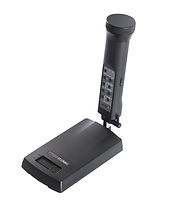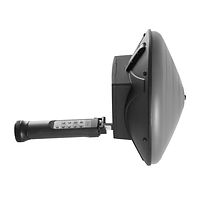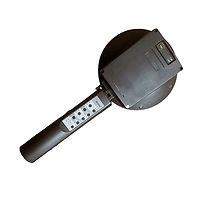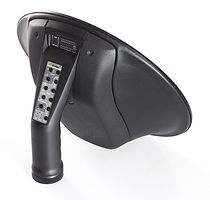
LORNET STAR
Lornet Star It has the world's first non-linear, integrated 2nd and 3rd harmonics spectrum analyzer, It has 3 frequency bands, 800 MHz, 2400 MHz and 3600 MHz, It is a junction detector with interchangeable transceiver units.
It is used after AM or FM decoding of the continuous mode signal via a visual spectrum analyzer or built-in speaker or headphones for efficient identification of artificial and natural semiconductors.
Key features
Working in high humidity absorbent environment
Remote detection by detection of small semiconductor elements and spatial selection of the target
Reliable SIM card detection from a distance of 10-15 cm
Universal control unit with interchangeable pain/transmitter unit with extension rod
Built-in spectrum analyzer of 2nd and 3rd harmonics, which improves the identification efficiency of semiconductor elements (only for 24,000 Mhz)
Clear and unambiguous measurement of power levels of signal and received harmonic waves
2. Automatic protection system against central frequency distortion by measuring the minimum noise in the receiver path of the harmonics
User-friendly interface and combined push-button control. No pre-installation required before getting started
The electromagnetic radiation to which the user is exposed is often lower than that set by the Regulator.

Technicial Specifications
Switchable transmit/receive barriers provide a scan signal in the following frequency ranges:
2400MHz,
800 MHz (optional antenna),
3600 MHz (optional antenna),
Types of sounding signals:
- Pulsed (with relative pulse duration of 44),
- Continuous (with AM demodulator),
- Continuous (with FM demodulator).
The (continuous) output power of the pulsed signal is at least 10 (0.3) W.
Spectrum Analyzer at 2nd and 3rd harmonic of probing signal with 40Hz resolution and 10kHz bandwidth.
The sensitivity of the 2nd and 3rd harmonics is at least 110 dBm (-140 dBW).
Dynamic display range of 2nd and 3rd harmonics is more than 40 dB.
Display of rebroadcast signals of 2nd and 3rd harmonics.
Detachable extension bar
Manual in the 20 dB range power adjustment.
Key Competitive Advantages
There is no analogue in the world.
The user can analyze not only the amplitude, but also the spectra of the 2nd and 3rd harmonic signals re-emitted by a nonlinear object according to the scanning frequency, which increases the informational content of the nonlinear properties of the object. In particular, it significantly simplifies decision making about corrosive and artificial semiconductors.
There is a built-in module that measures the strength of the reflected sounding signal from the research object, giving the possibility to estimate the extension of the reflective surface of the object.
The use of 3 interchangeable transmit/receive units provides significant advantages in all three frequency ranges, significantly reducing the chance of missing out on research operations:
- 800 MHz – relatively low signal attenuation in all weather conditions in dense environments (such as brick, concrete).
- 2400 MHz - possibility to detect SIM multiples and small (about 1 cm²) semiconductor devices,
- 3600 MHz – providing selection that simplifies research work in buildings with legitimate electronic equipment.
Replacing the transmitter/receiver units and the extension bar will not take more than a few minutes.
Features of Lornet Series Non-Linear Joint Detectors
All detectors of the series have the following general characteristics:
Two types of sounding signals: high-rate pulsed signal and continuous signal (so-called 20K model or low-rate pulse;
Automatic sounding signal frequency extraction from narrowband interferences;
Automatic and manual of pulsed signal strength adjustment;
Analysis of the received signal by 2nd and 3rd Harmonics;
Availability of wireless headphones.

Features of Lornet series models
The Lornet is a non-linear junction detector with a standard operating frequency in the 800-900 Mhz frequency range. Its distinguishing features are: easy to use, light (1 kg), environmentally friendly (max output power 10 W in pulsed mode) is designed for testing office buildings. It does not detect SIM cards due to the applied frequency band (otherwise a much more powerful (100-200 W) non-linear splice detector).

The Lornet-24 is a non-linear portable junction detector with an operating frequency of 2.4 GHz. Its distinguishing features are: easy to use, light weight (650 g), the design of the device is similar to a metal detection rod, environmentally safe (maximum power dissipation 10 watts in pulsed mode); It is designed for personal inspection, business travel use and local inspection of office buildings. Due to the applied frequency band, the device can detect SIM cards from a distance of 10-15 cm.

The Lornet-36 is a non-linear junction detector with an operating frequency of 3.6 GHz (it is currently the only detector at this operating frequency). Its distinguishing features are: easy to use, light weight (1.6 kg), effective parabolic antenna and microwave range allow choice it is environmentally safe (maximum output power is 20 watts when it pulses), It is used in anti-terrorist activities, to detect electronic components from 3-7 meters (search for suspicious substances, radio fused components). Due to the applied frequency band, the device can detect SIM cards at a distance of 1-1.2 meters.

The Lornet-36 mini Nonlinear junction detector is a modified antenna version of the Lornet 36. Its distinguishing features are: easy to use, light weight (1 kg), compact parabolic antenna applied, and microwave range of targets spatially. allow choice It is environmentally safe (maximum output power in pulse mode is 20 Watts), designed to inspect buildings (area optional) from a distance of 1-2 meters without removing legal electronic devices much. Due to the applied frequency band, the device can detect SIM cards at a distance of 0.8-1 meters.

Lornet-0836 is a dual frequency non-linear residential detector (currently the only one in the world) operating at 800 MHz and 3.6 GHz frequencies. Its distinguishing features are: easy to use, light weight (1 kg). The device combines the advantages of 800 MHz (detection in all weather conditions) and 3.6 GHz frequency ranges (for site selection), is environmentally friendly (maximum output power is 20 Watts when pulsing), electronic components are 3-7 meters away in anti-terrorist activities with an effective algorithm. Detects from a distance: initial detection and subsequent selection of the target. Due to the applied frequency band, the device can detect SIM cards at a distance of 1-1.2 meters.

Non-Linear Detectors Working Principle
The nonlinear junction locator, known as a semiconductor units detector or nonlinear transfer detector, is designed to detect devices containing semiconductor materials (diodes, transistors, circuits). Non-linear joint locators are used to detect remote control units of developed explosive devices, as well as detect electronic eavesdropping devices.
The working principle of the non-linear locator represents the high-frequency signal radiation of the object under investigation and the visual and auditory analysis of the second and third harmonic signal levels from the object. The non-linear joint locator is a mandatory device for any technical security service and its substitute law enforcement agency.
The operation of Lornet detectors depends on the properties of the local conductive components to create a reaction at the 2nd and 3rd harmonics when emitted by an RF sounding signal. In turn, semiconductor components of natural origin (eg, oxide membrane) will have a higher order of third harmonic reaction, while semiconductor components of artificial origin will have a higher order of second harmonic reaction. detectors; They analyze the 2nd and 3rd harmonic reactions of emitted objects that allow fast and reliable identification of electronic devices and natural oxide semiconductors.
The detectors automatically find the best noise-free and distortion-free receiver frequency, ensuring flawless operation even in complex electromagnetic environments. The frequency tuning algorithm built into the Lornet detectors automatically selects the RF sounding signal frequency so that the digital processing of the demodulated signal has maximum sensitivity while keeping the noise level in the 2nd harmonic receiver channel to a minimum.




